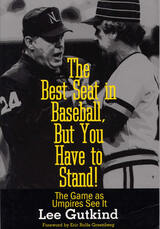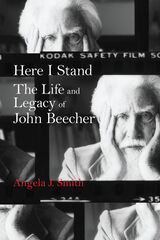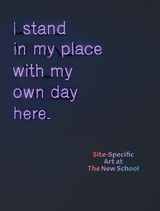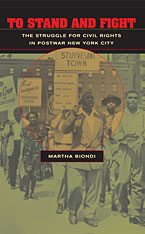
To provide this unique—if controversial—look at major league baseball as umpires see it, Lee Gutkind spent the 1974 season traveling with the umpiring crew of Doug Harvey (crew chief), Nick Colosi, Harry Wendelstedt, and Art Williams, the first black umpire in the National League. The result is an honest, realistic, insightful study of the private and professional world of major league umpires: their prejudices and petty biases, their unbending pride in their performance, their inside perspectives on the game, and their bitter criticism of the abuse often directed at their profession and at their conduct. As relevant today as it was in 1974, this illustrated chronicle shows how little has changed in the lives and duties of umpires in the last quarter century.
Guided by his passionate love for the game as he wrote The Best Seat in Baseball, But You Have to Stand!, Gutkind attempted to present the umpires in a positive but realistic light: "I portrayed them as real people, honorable, hard-working and dedicated, but with warts and flaws like the rest of us. But they didn't want to be compared with real people; they wanted to be umpires—on a plateau above most everyone else." Since the publication of this book in 1975, neither Harvey nor Wendelstedt have communicated with Gutkind, with Wendelstedt even denying that Gutkind traveled with the crew.

Few surnames resonate in American history more than Beecher. The family’s abolitionist ministers, educators, and writers are central figures in the historical narrative of the United States. The Beechers’ influence was greatest in the nineteenth century, but the family story continued—albeit with less public attention—with a descendant who grew up in Birmingham, Alabama, during the early twentieth century.
John Beecher (1904–1980) never had the public prominence of his famous ancestors, but as a poet, professor, sociologist, New Deal administrator, journalist, and civil rights activist, he spent his life fighting for the voiceless and oppressed with a distinct moral sensibility that reflected his self-identification as the twentieth-century torchbearer for his famous family. While John Beecher had many vocations in his lifetime, he always considered himself a poet and a teacher. Some critics have compared the populist elements of Beecher’s poetry to the work of Walt Whitman and Carl Sandburg, but his writing never gained a broad audience or critical acclaim during his lifetime.
In Here I Stand: The Life and Legacy of John Beecher, Angela J. Smith examines Beecher’s writing and activism and places them in the broader context of American culture at pivotal points in the twentieth century. Employing his extensive letters, articles, unpublished poetry and prose, and audio interviews in addition to his numerous published books, Smith uncovers a record of public concerns in American history ranging from the plight of workers in 1920s steel mills to sharecroppers’ struggles during the Depression to the civil rights movement of the 1960s.

Providing a kaleidoscopic view into these works, this richly illustrated volume explores each installation through three to four essays written by critics, poets, and scholars from diverse fields including anthropology, mathematics, art history, media studies, and design. Their texts are complemented by three additional essays reflecting on each piece's art historical significance; the architectural contexts in which the works reside on the university's campus; and The New School's relationship to adventurous art practice. Also included is a roundtable discussion among leading arts educators and artists who reflect on the pedagogical potential of a campus-based contemporary art collection. The book's final section presents a history of each commissioned work, highlighted by archival images never before published.
Published by The New School. Distributed by Duke University Press.
Contributors. Saul Anton, Daniel A. Barber, Stefano Basilico, Carol Becker, Naomi Beckwith, Omar Berrada, Gregg Bordowitz, Tisa Bryant, Holland Cotter, Mónica de la Torre, Aruna D'Souza, Elizabeth Ellsworth, Julia L. Foulkes, Andrea Geyer, Kathleen Goncharov, Jennifer A. González, Michele Greet, Randall Griffey, Victoria Hattam, Pablo Helguera, Jamer Hunt, Anna Indych-López, Luis Jaramillo, Jeffrey Kastner, Robert Kirkbride, Lynda Klich, Carin Kuoni, Sarah E. Lawrence, Tan Lin, Lucy R. Lippard, Laura Y. Liu, Reinhold Martin, Shannon Mattern, Lydia Matthews, Maggie Nelson, Olu Oguibe, G. E. Patterson, Hugh Raffles, Claudia Rankine, Jasmine Rault, Heather Reyes, Frances Richard, Silvia Rocciolo, Carl Hancock Rux, Luc Sante, Mira Schor, Eric Stark, Radhika Subramaniam, Edward J. Sullivan, Roberto Tejada, Otto von Busch, Wendy S. Walters, Jennifer Wilson, Mabel O. Wilson

The story of the Civil Rights Movement typically begins with the Montgomery bus boycott of 1955 and culminates with the 1965 voting rights struggle in Selma. But as Martha Biondi shows, a grassroots struggle for racial equality in the urban North began a full ten years before the rise of the movement in the South. This story is an essential first chapter, not only to the southern movement that followed, but to the riots that erupted in northern and western cities just as the Civil Rights Movement was achieving major victories.
Biondi tells the story of African Americans who mobilized to make the war against fascism a launching pad for a postwar struggle against white supremacy at home. Rather than seeking integration in the abstract, Black New Yorkers demanded first-class citizenship—jobs for all, affordable housing, protection from police violence, access to higher education, and political representation. This powerful local push for economic and political equality met broad resistance, yet managed to win several landmark laws barring discrimination and segregation.
To Stand and Fight demonstrates how Black New Yorkers launched the modern civil rights struggle and left a rich legacy.
READERS
Browse our collection.
PUBLISHERS
See BiblioVault's publisher services.
STUDENT SERVICES
Files for college accessibility offices.
UChicago Accessibility Resources
home | accessibility | search | about | contact us
BiblioVault ® 2001 - 2024
The University of Chicago Press









